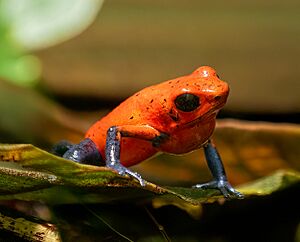List of amphibians of Costa Rica facts for kids
Costa Rica is an amazing country, home to a huge variety of animals, including many cool amphibians! Amphibians are special creatures that can live both in water and on land. They start their lives in water, often as eggs and then as larvae (like tadpoles), and later change into adults that can live on land.
Costa Rica has recorded 194 different kinds of amphibians. Sadly, three of these species are now extinct, meaning they have completely disappeared from the Earth. This list will introduce you to some of the main groups of amphibians you can find in this beautiful country.
Contents
Understanding Conservation Status
When we talk about animals, you might see letters like EX or LC next to their names. These letters tell us how much danger a species is in. It's like a report card for nature!
- EX (Extinct): This means the species is completely gone. We won't see them again.
- EW (Extinct in the Wild): These animals only exist in zoos or special protected areas, not in their natural homes.
- CR (Critically Endangered): These species are in extreme danger of becoming extinct very soon. They need urgent help!
- EN (Endangered): These species are also at a very high risk of extinction.
- VU (Vulnerable): These species are likely to become endangered if we don't protect them.
- NT (Near Threatened): These species might become vulnerable in the future, so we need to keep an eye on them.
- LC (Least Concern): These species are doing well and are not currently at risk.
- DD (Data Deficient): We don't have enough information about these species to know how they are doing.
- NE (Not Evaluated): These species haven't been checked yet for their conservation status.
Caecilians: The Hidden Amphibians
Caecilians (pronounced "seh-SIL-yuns") are a super unique group of amphibians. They look a bit like large worms or small snakes, but they are actually amphibians! Most caecilians live underground, burrowing through the soil, which makes them very hard to spot. They don't have legs, and their skin is smooth and often slimy.
Costa Rica is home to some caecilian species. One example is Oscaecilia osae, which is considered Data Deficient (DD), meaning scientists need more information to know how well it's doing.
Salamanders: Lizards' Amphibian Cousins
Salamanders might look like lizards, but they are amphibians! They have moist skin, usually four legs, and a long tail. Many salamanders in Costa Rica live in cool, damp forests, often hiding under logs or leaves. Some can even breathe through their skin!
Costa Rica has many different types of salamanders, especially from the family Plethodontidae. These include many species of Bolitoglossa and Nototriton. Some, like Bolitoglossa compacta and Bolitoglossa minutula, are Endangered (EN), while others like Nototriton major are Critically Endangered (CR). This shows how important it is to protect their forest homes.
Frogs and Toads: Leaping Wonders
Frogs and toads are the most well-known amphibians, famous for their jumping abilities and croaking sounds. Costa Rica is a paradise for these creatures, with a huge variety of shapes, sizes, and colors.
Busy Bufonidae: Toads Galore
The Bufonidae family includes many toads. Toads usually have drier, bumpier skin than frogs and often spend more time on land. One very famous toad from Costa Rica was the Golden Toad (Incilius periglenes), which is now Extinct (EX). This sad story reminds us how fragile nature can be. Other toads like the Cane Toad (Rhinella marina) are still common (LC).
Glass Frogs: See-Through Wonders
The Centrolenidae family is famous for its "glass frogs." These amazing frogs have skin on their bellies that is so clear you can see their internal organs, like their heart and bones! They are usually small and live near streams in the forest. Most glass frogs in Costa Rica, like Hyalinobatrachium fleischmanni, are of Least Concern (LC).
Rain Frogs: Masters of Camouflage
The Craugastoridae family, often called "rain frogs" or "robber frogs," is one of the largest groups of frogs in Costa Rica. Many of them don't need water to lay their eggs; their eggs hatch directly into tiny froglets! This makes them very adaptable. However, many species in this family, like Craugastor andi and Craugastor taurus, are Critically Endangered (CR).
Poison Dart Frogs: Bright Warnings

The Dendrobatidae family includes the famous poison dart frogs. These small, brightly colored frogs are known for the powerful toxins in their skin, which they use to protect themselves from predators. Their vibrant colors act as a warning! The Strawberry Poison-Dart Frog (Oophaga pumilio) is a common sight in some parts of Costa Rica (LC), while the Golfodulcean Poison Frog (Phyllobates vittatus) is Endangered (EN).
Other Interesting Frogs
Costa Rica is also home to many other fascinating frog families:
- Tree Frogs (Hylidae): This family includes many beautiful tree frogs, like the famous Red-eyed Tree Frog (Agalychnis callidryas). Many of these frogs are excellent climbers and have sticky toe pads. Some, like Agalychnis lemur, are Critically Endangered (CR).
- Leptodactylidae: These frogs often live on the forest floor and include species like the Tungara Frog (Engystomops pustulosus), known for its loud calls.
- Microhylidae: These are often small, round frogs, sometimes called "narrow-mouthed frogs."
- Ranidae: This family includes many "true frogs" that often live near water, like the Forrer's Grass Frog (Lithobates forreri).
- Strabomantidae: This is another large group of frogs that often lay eggs on land, similar to the Craugastoridae.
Protecting these amazing amphibians and their homes is super important for the health of Costa Rica's incredible ecosystems!
See also
- List of birds of Costa Rica
- List of mammals of Costa Rica
- List of non-marine molluscs of Costa Rica
- List of reptiles of Costa Rica

